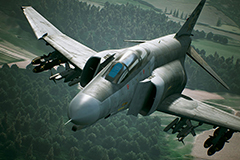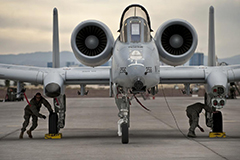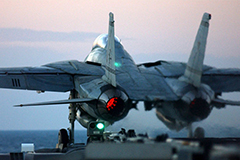1. F-22 Raptor History:
In 1981, the U.S. Air Force developed a requirement for an Advanced Tactical Fighter (ATF) as a new air superiority fighter to replace the F-15 Eagle and F-16 Fighting Falcon. Code named "Senior Sky", this program was influenced by the emerging worldwide threats, including development and proliferation of Soviet Su-27 "Flanker"- and MiG-29 "Fulcrum"-class fighter aircraft. It would take advantage of the new technologies in fighter design on the horizon, including composite materials, lightweight alloys, advanced flight control systems, more powerful propulsion systems, and stealth technology. More details
2. Harrier Jump Jet:
The Harrier, informally referred to as the Harrier Jump Jet, is a family of jet-powered attack aircraft capable of vertical/short takeoff and landing operations (V/STOL). Named after a bird of prey, it was originally developed by British manufacturer Hawker Siddeley in the 1960s. The Harrier emerged as the only truly successful V/STOL design of the many attempted during that era, despite being a subsonic aircraft, unlike most of its competitors. It was conceived to operate from improvised bases, such as car parks or forest clearings, without requiring large and vulnerable air bases. Later, the design was adapted for use from aircraft carriers. More details
3. F-16 Falcon Fighter Jet:
4. Mirage 2000 Fighter Jet:
5. Panavia Tornado:
6. F-4 Phantom Fighter Jet:
7. Lockheed F-117 Nighthawk:
8. Mig-25 and Mig-31:
The Mikoyan-Gurevich MiG-25 (Foxbat) is a supersonic interceptor and reconnaissance aircraft that was among the fastest military aircraft to enter service. It was designed by the Soviet Union's Mikoyan-Gurevich bureau, and is one of the few combat aircraft built primarily using stainless steel. It was the last plane designed by Mikhail Gurevich before his retirement. The Mikoyan MiG-31 is a supersonic interceptor aircraft developed for use by the Soviet Air Forces. The aircraft was designed by the Mikoyan design bureau as a replacement for the earlier MiG-25 "Foxbat"; the MiG-31 is based on, and shares design elements with the MiG-25. More details
9. F-15 Eagle Fighter Jet:
10. F-35 Lightning II Fighter Jet:
The Lockheed Martin F-35 Lightning II is a family of single-seat, single-engine, all-weather stealth multirole fighters. The fifth-generation combat aircraft is designed to perform ground attack and air defense missions. The F-35 has three main models: the F-35A conventional takeoff and landing (CTOL) variant, the F-35B short take-off and vertical-landing (STOVL) variant, and the F-35C carrier-based Catapult Assisted Take-Off Barrier Arrested Recovery (CATOBAR) variant. On 31 July 2015, the United States Marines declared ready for deployment the first squadron of F-35B fighters after intensive testing. More details
11. Eurofighter Typhoon:
The Eurofighter Typhoon is a twin-engine, canard-delta wing, multirole fighter. The Typhoon was designed and is manufactured by a consortium of Alenia Aermacchi (Leonardo since 2017), Airbus Group, and BAE Systems that conducts the majority of the project through a joint holding company, Eurofighter Jagdflugzeug GmbH formed in 1986. NATO Eurofighter and Tornado Management Agency manages the project and is the prime customer. The aircraft's development effectively began in 1983 with the Future European Fighter Aircraft programme, a multinational collaboration among the UK, Germany, France, Italy, and Spain. More details
12. F/A-18 Hornet Fighter Attack Aircraft:
13. Mikoyan Mig-35 Fighter Jet:
14. Dassault Rafale Fighter Jet:
15. Sukhoi Su-57 Fighter Jet:
16. Sukhoi Su-27 Fighter Jet:
17. A-10 Thunderbolt II Attack Aircraft:
18. F-14 Tomcat Fighter Jet:
19. A-6 Intruder Attack Aircraft:
20. F-22 Raptor Fighter Jet:




















